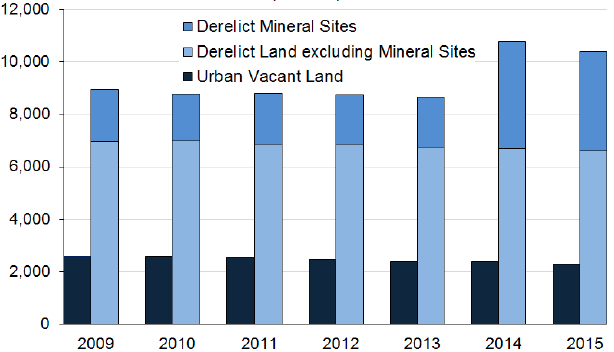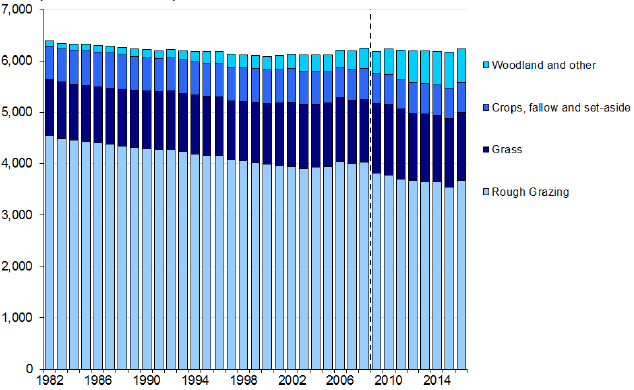Key Scottish Environment Statistics 2016
Reference document offering information on a wide range of environmental topics, covering key datasets.
This document is part of a collection
Land
Background
Land is an important part of the Scottish environment, supporting a range of habitats and species and providing a wealth of benefits such as food, timber, clean water, energy and employment. The way in which land is used and managed has implications for many areas such as water pollution, greenhouse gas emissions, human health and the economy; and is vital to the sustainability of the environment as a whole [96] .
Land Use Strategy
From Scotland's Environment website -
Get Informed section [97,98]

One of the outcomes of the Scottish Government Greener Objective [99] is to protect and enhance the natural environment. The Land Use Strategy 2016-2021 [100] , which is one of the commitments of the Climate Change (Scotland) Act 2009, builds upon the previous land use strategy and provides a set of Principles for Sustainable Land Use to guide policy and decision making in relation to land use.
Forestry
There are also specific guidelines in place to encourage the sustainable management of different sectors. For instance, the UK Forestry Standard sets out the standards for the sustainable management of all forests in the UK, on which the independent certification schemes for sustainable forest management are based.
As at 31 March 2016, 56% of Scotland's woodland area was certified as sustainably managed (807,000 hectares) [101] , although woodland that is not certified may also be managed sustainably.
Targets and Indicators
There are two National Indicators that relate to Scotland's land:
- Improve people's use of Scotland's outdoors [102]
- Improve the condition of protected nature sites [103]
The Land Use Strategy also has ten indicators that measure progress towards the delivery of the three Objectives of the Strategy [104] .
Derelict and Urban Vacant Land: 2009-2015 R
Area of derelict and urban vacant land (hectares) [105]

Why this measure is important
Derelict land together with vacant land in urban areas is an unused resource. Vacant land is land that is unused for the purposes for which it is held and is viewed as an appropriate site for development. Derelict land (and buildings) is land that has been so damaged by development that it is incapable of being developed for beneficial use without rehabilitation [106] .
Background
The Scottish Vacant and Derelict Land Survey is an annual data collection managed by the Scottish Government using data sourced from local authorities and the Loch Lomond and Trossachs National Park Authority. The main purpose of the survey is to provide a national data source to inform the programming of the rehabilitation, planning and reuse of derelict and urban vacant sites.
Trend
Since 2009, there has been an increase of 1,145 hectares (10%) in the total amount of derelict and urban vacant land recorded in the survey (including derelict mineral sites), from 11,530 hectares in 2009 to 12,674 hectares in 2015. The most recent survey (2015) showed a net decrease of 458 hectares from 2014.
Factors affecting trend
The increase in derelict land (including mineral sites) is mainly due to the addition of 2,217 hectares of former surface coalmines that became derelict in East Ayrshire in 2014. Urban vacant and derelict land can also be brought back into use; the area that is brought back into use each year can depend on the land's development potential, it's previous use and the potential funding available. In 2015, the most common new uses of the derelict and urban vacant land brought back into use were residential development (44%) and mineral activity (18%).
Source: Scottish Government
Metadata
Agricultural Land Use: 1982-2016 [107]
Area (thousand hectares)

Why this measure is important
Agricultural land use has a strong influence on the landscape and environment of Scotland. In particular, changes in agricultural land use have an impact on wildlife habitats, water pollution, and greenhouse gas emissions. Approximately four fifths of Scotland's land is used for agriculture, although this may also be used for other purposes [108] .
Background
There is a step change in the agricultural land use data series in 2009 following a switch in data source to the Single Application Form ( SAF). [109] This means that post 2009 data is not directly comparable to previous years and so trends should be treated with caution [110] .
Trend
Between 2009 and 2016, the total land used for agriculture in Scotland increased by around 1% from 6,176,800 hectares to 6,236,400 hectares. Since 2009, the area of woodland and other land [111] has increased by 237,600 hectares (57%) to 657,100 hectares in 2016 whereas the area of land used for rough grazing and the area of grass have decreased by 141,100 hectares (4%) and 32,900 hectares (2%) respectively over the same period.
Factors affecting trend
Though the area of woodland fell in the year to 2016, changes to the ways in which woodland was collected on the SAF in 2015 and 2016 may be a large factor in this fall and therefore the data for these years should be treated with caution. There has been a general upward trend in woodland over the last decade, however. While this may be partly due to increased coverage of this type of land by the June Census register, particularly in the years immediately following the use of SAF data from 2009, consistent increases over the last couple of decades suggests genuine increases have been driving this trend.
Source: Scottish Government
Metadata
Nutrients Applied to Crops and Grass: 1986-2015
Manufactured fertiliser nutrients applied to crops and grass (kg/ha) [112]

Why this measure is important
Fertilisers contain nutrients, such as nitrogen, phosphorus and potassium, which improve plant growth and crop yields. However, the inappropriate or mistimed use of fertilisers may cause nutrient enrichment and eutrophication of waters.
Background
Data on manufactured fertilizer [113] use is obtained from the British Survey of Fertiliser Practice, which is an annual survey based on a representative sample of farms which vary from year to year. The survey includes estimated average rates of manufactured fertiliser nitrogen, phosphate and potash applied to agricultural crops and grassland, excluding Orkney, Shetland and the Western Isles.
Trend
Potash, phosphate and nitrogen application rates have declined overall since 1986. The application rates of nitrogen and potash varied between 1986 and 2001, but have since declined. The application rate of nitrogen fell from 127 kg/ha in 2001 to 89 kg/ha in 2015 and the application rate of potash fell from 49 kg/ha to 34 kg/ha over the same period. The phosphate application rate remained relatively stable until 1997, before declining steadily to 27 kg/ha in 2015.
Factors affecting trend
The application rates for nitrogen are generally higher than those for phosphate and potash. Most agricultural soils do not contain enough naturally occurring plant available nitrogen and so need to be supplemented at certain times of year. Phosphate and potash can be held in large quantities by most British soils and so managing the supply of these is based more on maintaining appropriate levels in the soil. Weather, economic factors, subsidy regimes and cropping patterns all may contribute to changes in fertiliser use.
Source: Defra / Scottish Government
Metadata
Area of Woodland: 1924-2016 [114]
Area (thousand hectares)

Why this measure is important
Woodland is important as it provides wildlife habitats and can contribute to the sustainable production of wood products and paper. Woodland also contributes to the removal of carbon dioxide from the atmosphere, with the Forestry sector acting as a carbon sink.
Background
Data are obtained from forest inventories; however, most inventories have slightly different definitions of woodland and so some apparent changes in area over time are due to changing definitions. Data for 2016, as at 31 March, are the final results obtained from 'Forestry Statistics 2016'.
Trend
As at 31 March 2016, the area of woodland in Scotland was 1,436,000 hectares (18.4% of the total Scottish land area). This compares with 16.4% of the total land area in 1995 and 11.8% in 1980. 74% of the area of woodland is made up of conifers and 26% is made up of broadleaved species, both native and introduced. There were 4,600 hectares of new woodland planted in 2015-16.
Factors affecting trend
Increases in woodland area are mainly the result of new planting, which has increased in recent years due to the introduction of Scottish Rural Development Contracts, or by natural colonisation of trees on land near existing woodland. Decreases in woodland area can result from the conversion of woodland to other land uses. Regulatory approval, which normally requires the area to be restocked[115], is usually required before trees can be felled. However, trees may be permanently removed in some cases, generally for environmental reasons. The permanent removal of trees may also be authorised under planning regulations, to enable development.
Source: Forestry Commission
Metadata
Contact
There is a problem
Thanks for your feedback